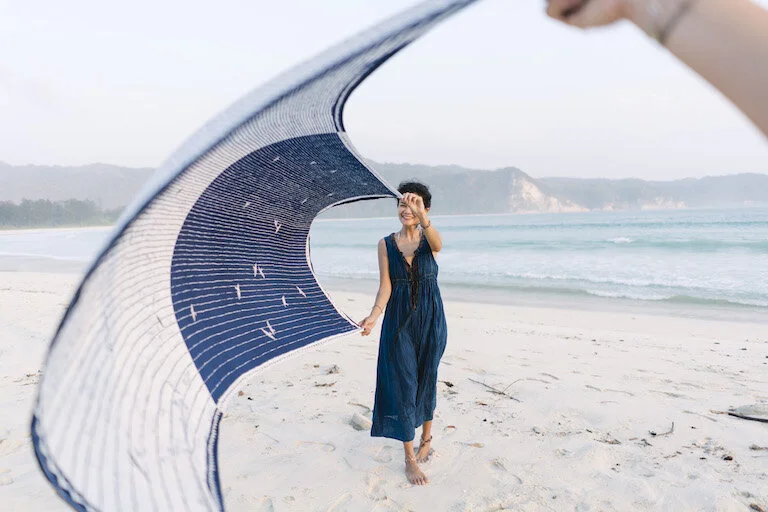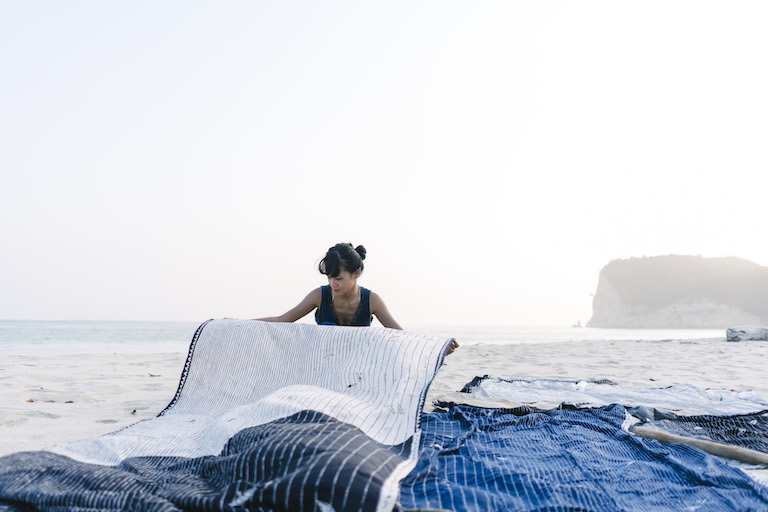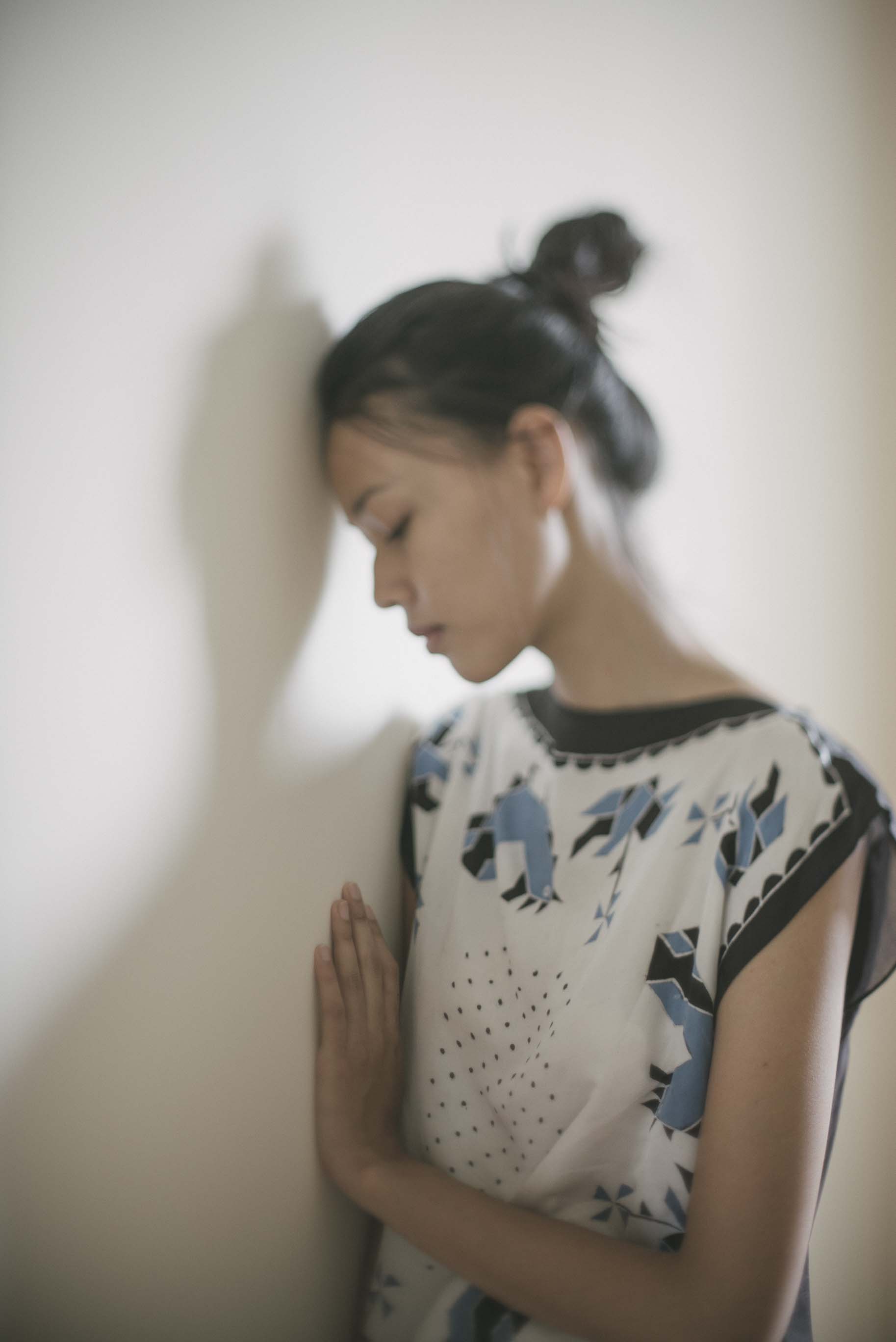Chitra Subyakto | Founder & Creative Director of Sejauh Mata Memandang
Chitra Subyakto is founder and creative director of Jakarta based, batik fashion house ‘Sejauh Mata Memandang.’ ‘As far as the eye can see;’ a textile brand that captured our attention and our hearts two years ago.
Chitra is one of those people you can’t help but instantly like, and be inspired by. She is known for her boundless talent as one of Indonesia’s most respected fashion creatives and textiles explorers; and oozes passion for her country, its culture and her people.
Chitra started her career as a fashion stylist, more recently she has styled for Indonesian movies and is influencing the Indonesian fashion world with her distinctive aesthetic. Her fresh designs on exquisite textiles place the beauty and craftsmanship of their makers at centre stage.
Today Chitra shares her story. It is a love story. With her generous heart and passionate spirit she is raising awareness locally and internationally of the ‘beauty and diversity’ of the ‘Now Indonesia' through her brand’s ‘creations and principles’.
*Kenalkan Chitra
(Image Sejauh Mata Memandang)
(Image Sejauh Mata Memandang)
Please tell us a little about your background. Where were you born, and where did you study?
I was born in Jakarta on December 3, 1972. My father was the first Admiral of the Indonesian Navy, and he was also Indonesia’s Ambassador to Turkey and Yugoslavia. I am the youngest of 4 siblings. I have 2 sisters and 2 brothers.
Because my father was in the Navy, he was strict as a parent, but he also introduced us to art, museums, temples and shows. As a child I thought it was so boring, but unconsciously it got inside of us. My parents were in love with the Indonesian culture.
Chitra's father in Navy uniform and to his right, Chitra's mother (Image supplied by Chitra Subyakto)
My mum wore the *kebaya every day. I was inspired by her fashion sense. As a young kid I would wonder why batik was ‘all brown’. Then my mum showed me her collection of batik which was very beautiful and some were colourful. It included the colours purple, orange and fuchsia, which were very unlike batiks of the time.
'My mum wore the kebaya every day. I was inspired by her fashion sense'
Right - Left : Chitra's mother, grandmother, aunty and grandfather (Image supplied by Chitra Subyakto)
This colourful batik collection of my mothers was designed by Go Tik Swan, a Javanese dancer at the Presidential Place of President Soekarno whose family were batik makers in Solo. In the 60’s, President Soekarno asked Go Tik Swan to make him a new style of batik.
Go Tik Swan was stressed by the request and so his teacher took him to Bali out of Java and his eyes were opened. He studied classics batik from Solo and Yogyakarta to make the new 'batik Indonesia' . He was also the teacher of Iwan Tirta, internationally known Indonesian Batik designer.
I planned on studying at Art School, but my dad told me that I couldn’t afford my life in this type of work. My 4 siblings are all artists. My father was worried, and encouraged me to study Economics, which I completed, but took it slowly.
What did you want to be when you were a child?
My dad put me in a classical Javanese dance class when I was 6 years old. I wanted to be a professional dancer. Then I stopped and focused on my study.
Have you always been interested in art and culture?
Yes, we grew up with antiques in our house. Our beds were antique which we loved, but other people would say ‘who has been sleeping there before you!’
Chitra's mother and father (centre) (Image supplied by Chitra Subyakto)
We understand throughout your career you have been a Costume Designer for motion pictures, a Fashion Stylist for magazines and TV commercials, Music Concerts, Music Videos as well as a Creative Buyer.
Can you share with us some of the highlights of your career, and work you are particularly proud of?
I started to work in magazines in the year of 2001. I was hired by Teen Magazine Cosmo Girl to work as a fashion stylist. At that time, I couldn’t find many clothes options to use for the teenager. And there weren't enough ‘Indonesian touch’ items I could mix and match at the time. Young people want their own identity, so I started to make clothes myself with a ‘touch of Indonesia’ for the concept of the fashion spread.
Then I started to style for the movies and music industry. I would make concepts for singers and bands, listen to their music, body shape, theme etc and give them concepts of how to dress according to their type of style. I also did commercials.
I love doing motion pictures, because it starts from a story and then I start to imagine how it’s supposed to look like. One of the movies I enjoyed working on is the film Laskar Pelangi (translated as The Rainbow Trooper) which was made in Belitung. Usually when I’m preparing to style for a film I will find stuff from here and there, but for Laskar Pelangi I had to make the clothes from scratch. It was interesting to make new clothes that looked smelly and dirty and real; because of this I enjoyed learning something new and it challenged me.
I made costumes for Laskar Pelangi the musical. The wardrobe for the musical was different, it needed to be friendly with the lighting. It had to be comfortable enough for the actor to sing and run, and everything is counted in seconds, to change costumes.
I’ve also worked as a Creative Buyer for Alun Alun, which I continued in for 6 years. Alun Alun is a concept store that offers high quality traditional Indonesian products. I would often travel to Solo and help the artisans to make the local products more attractive and sellable. For example I might suggest a change of zipper or lining for little details that count.
We would also love to hear more about your work in the recent Indonesian movie Ada Apa Dengan Chinta2? The Sejauh wardrobe in AADC2 was just beautiful!
It was fun to do it, because I was dressing different characters in the movie; one character wore pearls and heels, another wore Keds and sandals, another dressed ‘very Jakarta tourist.’ It was fun to style all the different characters.
What I liked the most was to add a ‘touch of Indonesia’ to make the look unique without looking ethnic, and make the person look nice yet still modern as well as suiting the character.
'What I liked the most was to add a touch of Indonesia’
To do this I would study each character’s body and skin tone on camera, study each character space; for example what their bedroom looked like, what car they used in the movie to help me achieve the look I wanted.
I believe that every person should love their shape and that fashion should enhance that.
A ‘touch of Indonesia’ for the film Ada Apa Dengan Cinta2 (What's Up With Love2) by Chitra (Image Sejauh Mata Memandang)
Your current role is Founder and Creative Director at Sejauh Mata Memandang. Can you tell us about the craftspeople you collaborate with to create your beautiful pieces, and the journey you've shared establishing simple designs for Sejauh?
I started with the help of people from the Museum Textile in Jakarta, to find potential crafts people I could meet. I was introduced to a range of people, then I started to explore. I travelled to Solo, Pekalongan and Yogyakarta in Central Java.
Kain (cloth) artisans are used to creating classic, beautiful and ornate designs, the whole kain, but for Sejauh I wanted to make something simple. Some get it, some not.
After awhile we found craftspeople who understood our brief. This process took time; some artisans thought the designs I would like them to create were too plain.
The craftspeople we collaborate with come from Java and Madura Island. The *Batik Cap are made by men because we need a constant pressure of the power of their hands. The *Batik Tulis is made by women. For SMM, our second line of Sejauh, all products are hand screened. Most of the artisans are men, because of the strength required.
All are my favourites, but I particularly like the red chicken motif that was made in Madura with their specific red colour.
'I particularly like the red chicken motif, made in Madura with their specific red colour' Chitra (Image Sejauh Mata Memandang)
Why did you choose the name Sejauh Mata Memandang - What is the significance of this name to you?
I love to travel. As I travel I say these words a lot, 'As far as the eye can see..it’s blue (the ocean)', 'As far as the eye can see it’s green (the trees) Indonesians don't usually use these words too much, we use a lot of slang because poetic language is too long, but I love it!
'As far as the eye can see..it’s blue' (the ocean)
'As far as the eye can see.. it’s green' (the trees)
When was Sejauh Mata Memandang established?
We launched in 2014, at the Harpers Bazaar Fashion Festival in Jakarta.
It took 2 years to develop the brand. I needed to study everything at this time, such as processing, the markets, the patterns etc. Everyday I studied more and more to be ready to launch.
Everyone who attended was very happy with what I had created. The designs were very honest and simple, as I made what ‘I like to wear’. The look is trendless and timeless because you can wear these textiles forever and these pieces are handmade, made by unique human beings not machines.
'The look is trendless and timeless because you can wear these textiles forever and these pieces are handmade, made by unique human beings not machines'
We don’t have a Spring or Fall collection rather a Rintik Hujan (drops of rain) collection and Kemarau (dry season) collection. I make what I can wear here in this tropical climate.
I’m not a fashion designer, I just love pattern and textile. And I love to style a scarf into a dress. I am a textile explorer.
'I’m not a fashion designer, I just love pattern and textiles. I love to style a scarf into a dress. I am a textile explorer'
Harpers Bazaar Fashion Festival Jakarta 2014 (Image Sejauh Mata Memandang)
Sajau's hand drawn Batik Algae series Batik Garis Laut (marked with lines out to sea) (Image Sejauh Mata Memandang)
How would you describe the Sejauh Mata Memandang style?
'Effortless, trendless, easy and simple, comfort, playful, all handmade by unique human beings'
What is your vision for Sajauh Mata Memandang?
I want to share stories about Indonesian culture, in the now, to the world. Indonesia is very beautiful and diverse. The art and culture scene is evolving massively here, it's accepted very well in the world. I want everyone to be aware of this. Sejauh is one of them, I want people to see the ‘now Indonesia' through Sejauh’s creations and principles.
Where does your inspiration come from for your collections?
Inspiration can be from anywhere, food, the sea, chickens, children
Stunning Sejauh textiles - Navy and white Noodle Bowl motif (Image Sejauh Mata Memandang)
We particularly love your ‘Algae Collection’ and ‘Noodle Bowls’. Can you tell us about your inspiration for these two beautiful collections.
The Algae collection was aerially inspired upon seaweed farms scattered in Indonesia’s waters. The lines of the wave and farm boxes from up above, the greens and blues and little farmers and fishermen’s boats.
Sitting together with my team brainstorming is where we often find inspiration. The Noodle bowl was there on the table and then we decided to use it as the motif for the Noodle bowl collection. (*the noodle bowl is iconic in Indonesia, depicting a rooster and a flower, and is used by food vendors on the streets of Indonesia)
Sejauh Noodle Bowl series - handwritten batik (Image Sejauh Mata Memandang)
What are the main Sejauh Mata Memandang products?
Kain, tops, bottoms, scarves and shawls, bags and accessories, pieces for the home and for kids
(Image Sejauh Mata Memandang)
Who is the Sejauh Mata Memandang shopper?
The young at heart, someone who loves to travel, is open minded, who wants to look good, yet effortless and stylish
'I believe a stylish person is someone who is comfortable in their own skin'
Any new projects you are working on at the moment?
Yes, I have been working on a movie which will be released in October called Athirah. It is a film based on the life of Vice-President Jusuf Kalla’s mother. The film tells the inspirational story of a woman and depicts the strong and rich Bugis culture of Makassar, South Sulawesi in the late 60s.
For the wardrobe I used vintage sarongs from Sulewesi, some from my own collection, and some I made myself. The women’s wardrobe relied on the use of pastel colours, but today it is hard to find pastels. The film will be released in Indonesia this October.
Fashion shows?
Batik Fashion Week began in Jakarta, on October 1. We held a fashion show at Plaza Indonesia.
Jakarta Fashion Week begins on 27 October at Senayan City, we're having two shows. One is for Sejauh Mata Memandang with our new pattern batik series. And one is for the SMM Collection. We will also hold an Exhibition in December about Ikat.
Can you list 3 resources that you turn to regularly for creative inspiration?
Nature, People, Stories - all my patterns have stories
3 words to describe your Jakarta?
Human, love, hate
Favourite place to eat in Jakarta?.
Home Mate in the Pelaspas building, Dharmawangsa for shaved ice
I also love Bubur Ayam Tanjung. Its in Menteng area near Cut Mutia mosque
The Dharmawangsa Hotel does a great Nasi Liwet
Chitra enjoying a shaved ice treat at Home Mate
Every visitor to Indonesia must Eat? Visit? Experience?
Eat - Nasi Padang ( best at Pagi Sore Cipete)
Visit - Komodo Island, Flores
Experience - Island hopping
Tea or Coffee? And where?
Tea, at home, I like Jasmine
I don't leave the house without?
My mixed Lavender and mint oil, antique rings from the Sriwijaya Kingdom. My wedding ring was designed and inspired by the Majatahit kingdom. (The ancient Javanese script on it is my husband’s name)
My life motto?
‘Supporting another’s success won't ever dampen yours’
We are totally enamoured with Chitra's designs and the story behind each piece, and knew you would be too. Below we have included the full range of Sejauh Mata Memandang suppliers to ensure you have a chance to see the full collection.
Where can our readers see, touch and purchase Sejauh Mata Memandang?
Dia.lo.gue Artspace - Kemang
The Goods Dept - Pacific Place and Plaza Indonesia
The Good Things in Life - Pondok Indah
Alun Alun indonesia
On Market Go (OMG+) Mall Tunjungan Plaza Surabaya
Potato Head Bali
Home Mate Bali
Where can our readers see and purchase online?
Web: Sejauh Mata Memandang
Online store: Shop Sejauh
Instagram: Sejauh Mata Memandang
Glossary* Batik- Resist-dyed cloth
* Batik Cap - Block -printed cap
* Batik Tulis - Hand drawn batik, a technique where wax is applied using the canting tool
* Kain - An unsewn cloth or skirt cloth
* Kebaya - A long sleeved tailored blouse decorated with lace and embroidery worn with a batik sarong
* Kenalkan - Let me introduce
* Pagi-Sore Morning - Afternoon cloth, a cloth with two different patterns divided by a diagonal or straight line in the centre
Words: Liz McClean and Chitra Subyakto Photography: Sejauh Mata Memandang and a journey bespoke

















